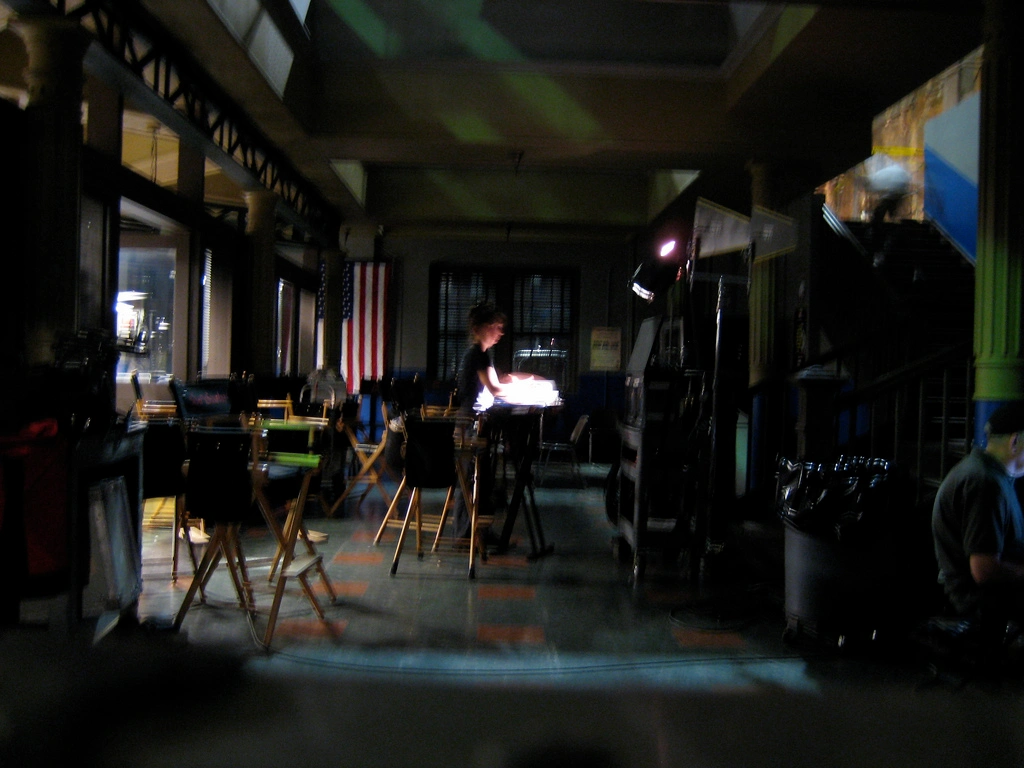Martha Pinson with Sidney Lumet on the set of ‘Night Falls on Manhattan’ Photo Credit Adger Cowans
Mr. Lumet is perhaps one of few major directors who consistently utilized a two or three week, six-hour-per-day rehearsal period prior to Principal Photography in which he prepared his actors in terms of interpretation, staging, and blocking.
I observed that Lumet’s approach cleared up uncertainty about the arc and pitch of an actor’s role, the tone of a performance, the intensity needed for any given scene in relation to what comes before and after. Sometimes on films there are unfortunate surprises and setbacks, such as when an actor comes prepared with an interpretation that is not in keeping with, or is contrary to, the vision of the director. But on a Lumet film the cast was able to run the “film” in pre-production rehearsal so the arcs could be worked out, invented,internalized. Each scene could be understood and shaped. The cast could be directed in a consistent interpretation of the director’s choosing. They had the opportunity to try things to find the character in a safe setting. Questions about historical context, lines, tone, motivation, and sub-text could be explored and/or answered. The actors and director had time to think, make suggestions, mull over what might be missing. Dialogue changes could be made, ad-lbs and inventions incorporated. He would have them work for what he felt was the right pace once other qualities were in place. He remarked that he had a better sense of the whole, that he could make better decisions in the relatively “safe” rehearsal weeks than he could during shooting when he’d been up since 5am and under pressure to “make his day.” Minor characters had an opportunity to experience their part in relation to the whole and learn what they must do. He would tell the actors after a great run-through, “That’s a print!” In this way, he communicated to them where he wanted them to be in emotion and performance on the shoot day. He trusted them to be ready. There are many ways of preparing but this seems like a brilliant one. 
Martha Pinson and Sidney Lumet Photo By Kerry Hayes
The Director of Photography (and others) attended the final run-through on the last day of rehearsal and would then know the staging. It is important in the Lumet approach that the work of the actors came first – shots
There was an evolution of trust and friendship, the heading off of problems, the confronting of conflicts and the telling of jokes – all the unpredictable and intangible things that come out in a creative enterprise with a deadline approaching. Among other things, Mr. Lumet was an aficionado of Vaudeville and could be relied on to render some priceless bits. But mostly, everyone learned, he was “all about the work.” It goes without saying that his insights, knowledge and leadership qualities were in evidence. 
Sidney Lumet and Martha Pinson on the set of ‘Prince of the City’ photo by Louis Goldman
In addition to the work with the cast, Mr. Lumet would have extensive planning meetings and scouts with his team. Elaborate plots and diagrams of camera positions (including lenses), action sequences, stunts, were designed, revised and published. The upshot of his planning was phenomenal. One day on Stranger Among Us we had a 7am call in the jewelry district to shoot a multiple camera action sequence including stunts. We did 48 setups to complete the work and wrapped before lunch!
Martha Pinson is a director, screenwriter, and formerly film technician based in New York City. Directing credits include: “Tomorrow,” a UK indie feature film that won Best Narrative Feature at Seneca FF, NY, SCAD Savannah FF, and Napa Valley FF, CA. Plans are in the works for more screenings and distribution. Prior directing work includes: “It’s Not Saturday,” a dramatic short done under VisionFest’11 Filmmaker’s Challenge. She directed the Drama Book Shop staged reading Series (2010), “King Alive” (2006), Sheila Evan’s “Billie Holiday Cabaret” (2005), and the award-winning short, “Don’t Nobody Love the Game More than Me” (2002), which aired nationally on the PBS. More theater directing credits: Bob Rogers’ “Small Potatoes” (2000), Stephen Mantin’s “Acts of Faith” (1998) – both off-Broadway full-length plays. She was a Second Unit Director on the film “Just the Ticket” starring Andy Garcia. Martha has written numerous original and adapted screenplays, including the award winning “Body Count 1968” and a miniseries treatment that is in development. She has been a Script Supervisor for major directors including Martin Scorsese, Sidney Lumet, Milos Forman, Oliver Stone, and Andrew Niccol.



